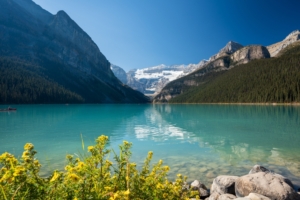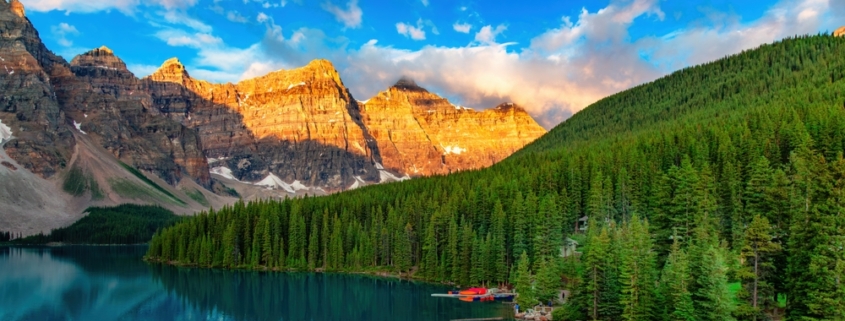What You Can Expect to See While Visiting Head-Smashed-In Buffalo Jump
If you plan to visit the Canadian Rockies anytime soon, Head-Smashed-In Buffalo Jump is well worth the stop. Head-Smashed-In Buffalo Jump in Canada, located in southwestern Alberta, is a historic treasure that hints of techniques and tales of years past. It was a staple hunting technique that Indigenous peoples used to kill massive herds of bison all at once.
Today, the 60-plus-foot sandstone cliffs paint a vivid picture of the techniques used in the hunt. It’s an intriguing stop, especially if you appreciate the history of years gone by (we know we do!). Here’s what you can expect to see during your visit.
Exploring the History of Head-Smashed-In Buffalo Jump
Head-Smashed-In Buffalo Jump, a UNESCO World Heritage Site since 1891, is a remarkable place with a deep connection to the Indigenous peoples of the North American plains. First used in 4,000 B.C., this buffalo jump was integral to bison hunting for many years.
The Legend of the Name
Head-Smashed-In Buffalo Jump is quite the name. It doesn’t paint a particularly pleasant picture of the site that draws countless visitors yearly. Unfortunately, the legend behind the name is just as macabre.
Despite popular belief, the name does, in fact, not stem from the gruesome end the buffalo met at the bottom of the canyon. Instead, the name comes from a young Blackfoot who wanted to gain a different perspective on the hunt. As legend goes, this young man wished to watch the buffalo plunge from the cliff from the canyon below.
Unfortunately, he stood too close when the buffalo began leaping from the cliff far above. As the creatures leaped to their deaths, crashing down into the canyon far below, he was crushed. Later, the Blackfoot found him beneath the pile of carcasses; his head smashed in due to the sheer weight of the animals and the blunt trauma of the falling creatures landing atop him. And, so, the buffalo jump got its name.
Historical Significance
Head-Smashed-In Buffalo Jump is one of the oldest, largest, and best-preserved sites that whispers of practices long since abandoned. It gives us a clear idea of the communal hunting techniques that Plains people leveraged, particularly when hunting bison.
The jump allowed the Indigenous peoples to hunt and harvest larger amounts of bison, which would have otherwise been very difficult using traditional hunting methods. The workings of the hunt were fascinating.
However, while the cliffs undoubtedly steal the spotlight, they’re not the only thing you’ll find here. The surrounding landscape is remarkably preserved, painting a larger picture of the whole operation. There’s a gathering basin and over 500 stone cairns, or piles of rocks used for marking, all of which helped funnel the bison toward the cliff.
The Workings of the Hunt
When the time came to hunt, the community worked together to hunt, kill, and process the massive herds of bison. If they waited too long, the meat would spoil, so this operation required a team effort.
It started with the buffalo runners. These were skilled hunters who disguised themselves as bison and wolves, leveraging their experience and disguises to lure the herd toward the cliffs. When the time came, the runners, along with help from other hunters, would stampede the herd over the cliff.
The herd careened over the cliff to its death, landing at the bottom, about 65 feet below. Others waited at the bottom, a safe distance from the falling bison, to kill any that survived the fall. After the stampede was complete and all bison were dead, the community processed the meat.
They used nearly every part of the bison—nothing went to waste. It took days to process the hundreds of bison that died in the stampede, but after all was said and done, the community had impressive stores to last through the seasons. They tanned the hides for clothing and blankets, used the bones to make tools, removed the sinew for thread, dried the meat, and boiled the bones to remove grease.
What to Expect From Your Trip
If you’re planning to visit Head-Smashed-In Buffalo Jump, you’re in for a treat (especially if you love learning about different cultures and history). You’ll get to enjoy spectacular cultural experiences and beautiful panoramic views. If you’re lucky, you might even spot a critter or two as you meander along the network of walking trails.
Incredible Cultural Experiences
When you visit Head-Smashed-In Buffalo Jump, you’ll get to immerse yourself in an intriguing cultural experience that brings the traditions, customs, and beliefs of the Plains People to life.
First up, visit the site’s interpretive center. In here, you’ll find all sorts of information about the history and culture of the people that once resided and hunted in this area. The center is somewhat of an architectural marvel—it’s built into the hillside to blend with the natural landscape.
You’ll get to learn about the story of the buffalo jump, from its geological formation to its historical significance, through the many exhibitions scattered throughout. Most of the exhibitions feature artifacts, multimedia presentations, and interactive displays.
For example, there are a couple of displays featuring bison hides with informative descriptions and a blurb about one of the many facets of life in those years. Other displays showcase what the Plains people did with other parts of the bison—carved horn and hoof drinking cups, bone weapons, and hide bags.
There’s even a diorama that shows a buffalo hunt in progress. It’s a portrayal of how the Plains people worked together to drive the buffalo over the cliffs. An audio presentation accompanies the diorama, explaining the techniques and strategies required for a successful hunt.
Aside from the exhibitions, you can also participate in various programs and events. For example, there are traditional drumming and dancing performances, storytelling sessions, and craft demonstrations. You can partake in guided tours, where you’ll learn more about the site and its history (we highly recommend these, especially if you’re a history buff—they’re well worth it).
Panoramic Views

The historical and cultural significance alone is enough to warrant a visit to Head-Smashed-In Buffalo Jump. But if that weren’t enough, you’ll also get to enjoy the incredible natural beauty of the area. The sandstone cliffs are surrounded by rolling hills and expansive prairies.
If the day is clear and you stand atop the cliffs, you can see far and wide—the landscape feels so vast, evoking a sense of the open spaces and boundless skies that characterize the North American plains. You can see for miles in every direction—it’s simply spectacular. If you’re lucky, the day might even be clear enough to spot Loaf Mountain, Drywood Mountain, and Victoria Peak dominating the horizon to the south of the jump.
The lands are dotted with native grasses, wildflowers, and shrubs. If you’re up for a stroll, you can walk along the assortment of trails that allow you to explore the lands surrounding the cliff. These trails wind through the prairie, giving you a closer look at the local flora and fauna.
Lots of Wildlife
As you’d probably guess, the region is home to all sorts of wildlife. While the bison were once plentiful in this area, roaming the plains in massive herds, they’re long since gone. They no longer live in this area in the vast number of years past, but they still remain a symbol of the area’s natural heritage.
While you meander through the site, you might be lucky to spot various wildlife species, such as pronghorn antelope, deer, coyotes, rabbits, and ground squirrels. You might even spot an assortment of birds soaring above, including hawks, eagles, and songbirds.
If you do spot a few critters during your visit, remember to keep your distance. Watch them go about their business, but don’t attempt to approach or pet any animals.
Visit Head-Smashed-In Buffalo Jump on a Guided Tour With Caravan
Head-Smashed-In Buffalo Jump is more than a neat-looking sandstone cliff—a visit here is an opportunity to learn about the history and traditions of the Indigenous peoples of the North American plains. It’s a peek into years past, shedding light on the timeless practices, communal hunting, and resourceful utilization of bison by the Plains People. After visiting more than a time or two, we think this stop is well worth it (especially if you’re a history buff or cultural enthusiast).
Ready to explore all Head-Smashed-In Buffalo Jump has to offer? Our guided tour will take you there. We offer a nine-day tour of the Canadian Rockies & Glacier, hitting some of the best spots along the way, including Head-Smashed-In Buffalo Jump.
When you take this trip, you’ll get to explore the breathtaking beauty of the Canadian Rockies and the nearby plains, stopping in all sorts of places. And the best part? You won’t have to plan nearly anything (except for your flight). We plan all of the details, including transportation, lodgings, and activities. This way, you can kick back, relax, and enjoy your vacation to the fullest without sweating the details.
If you’re ready to go on an adventure and explore the history of Head-Smashed-In Buffalo Jump (and more), book a trip with us today. Call 1-800-CARAVAN or 1 (312) 321-9800 to get started.
